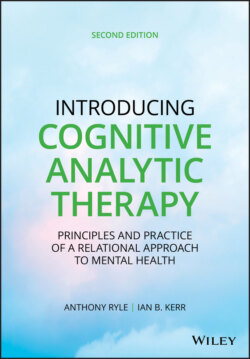Читать книгу Introducing Cognitive Analytic Therapy - Anthony Ryle - Страница 32
The Development of Sequential Diagrammatic Reformulation (“Mapping”)
ОглавлениеThe description of problematic sequences is a central aspect of reformulation, but clear verbal descriptions of complex processes can be difficult to construct and remember. With experience, they were increasingly supplemented or replaced by the use of sequential diagrammatic reformulation (SDR). More detailed discussion of the construction of these diagrams or “maps,” with illustrative examples, can be found in Chapter 6. In their simplest form they were flow charts, which may arise from an initial, joint sketch of a patient's core “subjective self,” linking aims to outcomes and indicating how problem, possibly symptomatic, procedures fail to achieve the intended aim. With the development of the PSORM they came to be drawn in a way which demonstrated the generation of problem procedures from the patient's (formative) RR repertoire, which was listed in a box as the core of the diagram. This activity remains central to the practice of CAT and has the additional powerful effect of validating a patient's experience and strengthening the sense of working together, and so of the therapeutic alliance.
An idea of hierarchy was implicit in the model, in that the very general patterns described in reformulation were seen to be manifested in a variety of detailed actions and roles in everyday life and including in therapy. (The patterns themselves are, of course, generalizations arrived at during reformulation from the consideration of these various detailed examples.) Also implicit was the assumption that procedures were mobilized appropriately in terms of the situation and according to the individual's aims, through the largely unconscious operation of meta‐procedures which also served to link together and harmonize the array of available procedures.
Recognizing and describing the RR and RRP repertoire provides a new basis for the patient's self‐reflection and is of particular value in helping therapists to avoid reciprocating (colluding with) the patient's damaging or unhelpful role procedures. In contrast to most short‐term therapies, CAT does not select a limited focus but seeks rather to identify and describe these general, high‐level procedural patterns and their underlying relational origins (RRs). Such “strategic” patterns will have been formed by, and will be manifest in, a range of detailed “tactical” behaviors. People are often only dimly aware of these general patterns, which are developed in early childhood. But they are not “dynamically repressed” (that is, their inaccessibility does not have the function of avoiding painful or forbidden memories and desires), and their description and recognition can allow rapid change over a wide spectrum of situations. An essential CAT therapist skill during reformulation is to be good at seeing what overall patterns are suggested by detailed events or repetitions. Discussing with a patient whether a particular episode is an example of a more general pattern nearly always elicits parallel examples which may confirm or modify the pattern.
Verbal or diagrammatic descriptions of these patterns should ideally be made in joint work using, as far as possible, the patient's own words and images. These are essentially descriptions abstracted with the therapist's help from the patient's witnessed or reported strategies. It is often possible to identify the repertoire without discussing early developmental history in any detail, although therapists may make suggestions such as, for example, “do you think this pattern might come from your relationship with your father?” or, “it sounds from what you say as if these early experiences left you feeling unworthy and only lovable if you were always there for others”? The recollected patterns of interaction in the childhood family (even though their historical accuracy may be uncertain) are often the clear precursors of key current procedures. However, many important relational experiences in the first few years of life, including possibly in utero, occur pre‐verbally and long before the ability is developed to lay down recoverable memories. Nevertheless, these will also be internalized and incorporated (literally), often at a deep level, psychologically, neuro‐biologically, and bodily, with important implications for therapy (see Cozolino, 2014; Corrigan & Hull, 2018; Gantt & Badenoch, 2013; Kerr et al., 2015; Northoff, 2014; Panksepp & Biven, 2012; Schore, 2012; Siegel, 2012; and see Chapters 3, 4, and 6). The aim of historical inquiries is not, therefore, to literally reconstruct the past, nor to blame those involved, so much as to explore what conclusions have been drawn from it. These may be based on partial or distorted memory but are seldom pure fantasy. CAT therapists base their comments on what can be seen or has been reported; they do not offer interpretations of a, possibly autonomous, “unconscious.” However, comments like “you seem to finish up acting as if everyone is bound to leave you” might well be appropriate. The vast majority of relevant mental processes are unconscious, but claiming to know what the patient could not know, as in so‐called “deep” interpretations, plays no part in CAT practice. Such interpretations are likely to be reflections of (dubious) theory at least as much as they are linked to the patient's processes.
